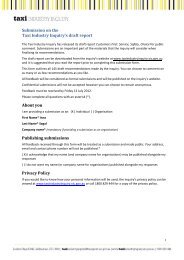Part D â Understanding and improving industry performance (PDF ...
Part D â Understanding and improving industry performance (PDF ...
Part D â Understanding and improving industry performance (PDF ...
Create successful ePaper yourself
Turn your PDF publications into a flip-book with our unique Google optimized e-Paper software.
Electronic payment systems<br />
Taxi licence conditions require that all vehicles in Victoria<br />
be fitted with an electronic payment system capable of<br />
processing the government taxi subsidy program known<br />
as the Multi Purpose Taxi Program (MPTP), with a small<br />
number of exceptions in the country. The only system<br />
able to process the cards associated with this program<br />
is the Cabcharge owned system. As a consequence,<br />
all Victorian taxis must be fitted with a Cabcharge EFT<br />
terminal. Electronic Payments received through this system<br />
(Cabcharge charge card or credit <strong>and</strong> debit cards) are<br />
disbursed to the operator via the NSP. 22<br />
Vehicle fit-out <strong>and</strong> repair<br />
Both of the dominant NSPs in Melbourne provide<br />
vehicle fit-out workshops to their affiliated operators that<br />
install <strong>and</strong> repair in-cab equipment such as mobile data<br />
terminals, EFT payment systems, meters <strong>and</strong> cameras.<br />
These workshops have exclusivity for installation <strong>and</strong><br />
maintenance of some equipment, such as the mobile<br />
data terminal, GPS system <strong>and</strong> EFT equipment. The<br />
inquiry underst<strong>and</strong>s that some or all of these services<br />
may be considered necessary <strong>and</strong> form a core part of the<br />
provision of services by an NSP.<br />
Taxi driver training<br />
As discussed in chapter 13, people seeking to be<br />
accredited as a taxi driver in Melbourne must first<br />
complete a training package with an approved registered<br />
training organisation (RTO). Currently, four RTOs offer<br />
this training: one is owned by a large taxi operator,<br />
one is independent <strong>and</strong> two are linked to NSPs. The<br />
inquiry underst<strong>and</strong>s that the NSP-linked RTOs have the<br />
dominant market share of taxi driver training. 23<br />
NSPs also offer network access training <strong>and</strong> remedial<br />
training. This training may be undertaken on a voluntary<br />
basis or be imposed on the driver under the NSP rules<br />
(such as following a complaint against a driver).<br />
Finance <strong>and</strong> insurance<br />
Finance for equipment or licences <strong>and</strong> business<br />
insurance for taxi operators is known to be offered by<br />
the Cabcharge-owned NSPs. These services are also<br />
offered to taxi <strong>industry</strong> participants by companies outside<br />
of the taxi <strong>industry</strong>. The inquiry underst<strong>and</strong>s that these<br />
services may be bundled <strong>and</strong> that taxi operators can pay<br />
for them by having regular payments deducted from their<br />
electronic revenue disbursements.<br />
Taxi licence brokering<br />
Designated taxi licence traders (known as brokers)<br />
provide a ‘matching service’ between the buyers <strong>and</strong><br />
sellers, <strong>and</strong> assignors <strong>and</strong> assignees, of taxi licences. As<br />
discussed in chapter 10, a larger number of licences are<br />
transferred or assigned through brokers affiliated with the<br />
major primary NSPs.<br />
Vertical integration by the primary NSPs can help promote<br />
efficiency in the <strong>industry</strong> as the NSPs are well placed to<br />
achieve economies by undertaking these extra activities.<br />
There is a concern, however, that vertical integration<br />
could also serve to entrench market power <strong>and</strong> restrict<br />
competition. To avoid this, it is important that any<br />
unwarranted restrictions between NSPs, at the horizontal<br />
level, be removed. In particular, barriers to entry <strong>and</strong> to the<br />
establishment of new NSPs need to be minimised.<br />
11.2.3. Secondary networks <strong>and</strong> trunk<br />
radio groups<br />
In addition to the m<strong>and</strong>atory affiliation with a primary<br />
NSP, taxi operators may belong to a secondary<br />
network. Secondary networks vary in size <strong>and</strong><br />
complexity <strong>and</strong> are commonly characterised as<br />
a collection of experienced drivers <strong>and</strong> operators<br />
who aim to deliver a higher quality service.<br />
A driver or operator may be a ‘member’ of a<br />
secondary network <strong>and</strong> can market their services<br />
directly to customers. Network members generally<br />
communicate with each other through a trunk radio<br />
installed in the taxi vehicle <strong>and</strong> use the radio to share<br />
work to meet dem<strong>and</strong> when they are unable to<br />
service the customer directly themselves. Secondary<br />
networks are a more recent service offering <strong>and</strong><br />
appear to be gaining popularity with customers,<br />
particularly in the corporate <strong>and</strong> disability sectors.<br />
Historically, operators <strong>and</strong> drivers were unable to offer<br />
a service directly to customers before the advent of<br />
mobile phone <strong>and</strong> pager technology. In the early 1990s,<br />
advances in telecommunications enabled this physical<br />
constraint to be overcome, making it possible for a<br />
customer to contact their driver of choice at any time.<br />
The formation of secondary networks has enabled these<br />
drivers to pass jobs on to other trusted drivers to ensure<br />
service continuity <strong>and</strong> customer satisfaction during busy<br />
times or when they are off duty.<br />
22 Taxi payment systems are discussed further in chapter 12<br />
23 See section 13.2.1 for further discussion on driver training <strong>and</strong> RTOs<br />
228
















